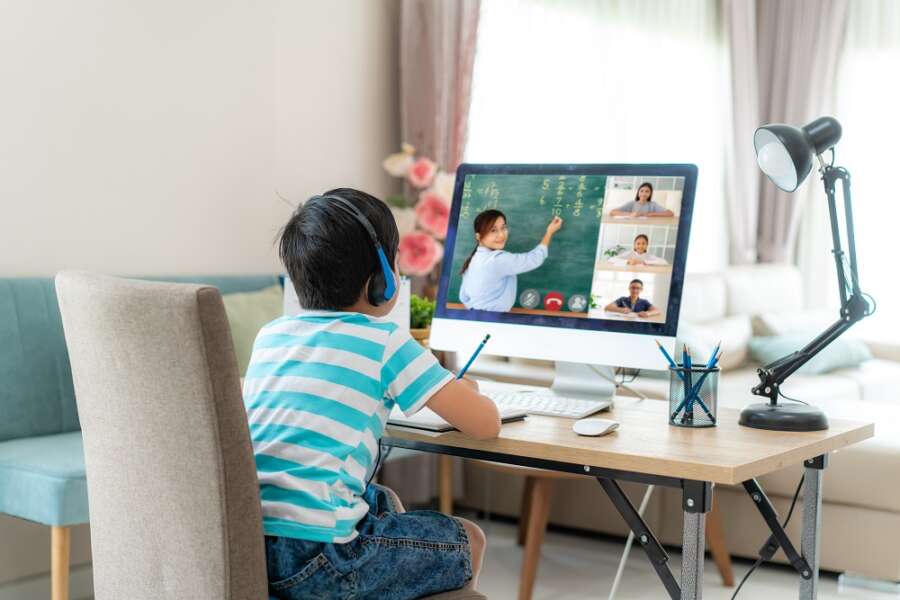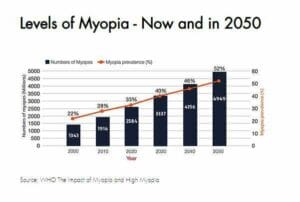
Cases of Myopia (near-sightedness) have doubled since the 1960s and will double again by 2050 (WHO)
Myopia can lead to serious sight-threatening conditions and can even lead to blindness
A new resource launched by industry experts to build awareness – myopiafocus.org
A new campaign and educational resource has been launched to focus on the myopia epidemic gripping children in the UK. Myopia (also known as short-sightedness) affects one in three people in the UK; however, it is now twice as common as in the 1960s. High myopia can cause serious eye problems later in life, including complications that could lead to blindness.
The latest research published at the end of 2021 has shown there is an association between screen-time and the risk and progression of myopia. Optometrists are seeing a sharp rise in the number of cases of children who are struggling to see the board at school. The pandemic and lockdowns have accelerated this alarming change.
The crisis has led Optometrist, Jason Higginbotham, alongside a team of leading myopia specialists, to launch the resource MyopiaFocus.org, a new parent-focused portal to raise awareness of the myopia epidemic, connect parents with local myopia management specialists and help them understand their child’s condition.
He says, “I’ve launched this campaign because I am concerned at the lack of understanding and support for what is going on with children’s eyes right now. Increased use of screens, close work, and lack of outdoor time have been proven to have had a significant impact on myopia becoming an epidemic. The genetic element of myopia will also compound the issues caused by modern lifestyles.
Mr Higginbotham continued: “We need to highlight the urgent need for proactive myopia management. A personalised eye care plan can significantly decrease the progression of myopia in children by as much as 50 per cent or more. As people are unaware that eye tests in schools are limited, unless parents act and have their child’s eyes tested, myopia may go undetected.”
Myopia is now considered by the World Council of Optometry (WCO) as a ‘serious eye condition that all children should be screened for’. The World Health Organization (WHO) predicts that up to half of all people will have myopia by 2050. In 2015, the WCO declared that the ‘standard of care for myopia must include early detection in children, allowing myopia management with evidence-based treatments to prevent catastrophic healthcare effect.’ Progress in delivering these objectives has not been rapid enough.

In the years before screens, children played outside, which provided more natural light and allowed the eyes to focus on long distances. Now, with play and education using iPads, phones, and computers, the eyes are too regularly focussed on objects right in front of them. There is less distance viewing and less light, and little switching between focuses because children are more likely to be indoors.
Prominent myopia management specialists are backing the portal, including Optometrist of the Year 2020, Dr Keyur Patel from TK&S Optometrists, who said: “For many years, it was felt that a refractive solution was all that was needed to ‘treat’ myopia. Since as early as 1998 we have known that increasing myopia with increasing axial length puts our patients at increased risk of (currently) irreversible visual disability and, in the worst cases, blindness.
“We now have many tools at our disposal to try to reduce the potential levels of myopia, and it is up to eyecare professionals to educate our patients. Myopia Focus provides a valuable resource and I hope it can help kick start these conversations with parents.”
Leading myopia management pioneer, Bhavin Shah from London-based Central Vision Opticians, said: “Many parents have been able to help slow down the deterioration in their child’s sight but there are significantly more who aren’t aware about the latest technology that can help their child. At every eye test, their kid’s eyes get worse, and they end up getting stronger glasses. Parents must know that we can break that cycle and reduce the rate of change to help protect their children’s eyes. They need to start as soon as possible to make the biggest impact.”
In addition, Myopia Focus has launched a change.org campaign, which seeks to get the NHS to recognise myopia as an ocular disease and fund myopia management. Myopia onset usually occurs between six and thirteen years of age – earlier-onset is associated with higher levels of myopia in adult life. 2.6 billion people in the world are myopic, and places like Singapore and South Korea have very high concentrations with 80 per cent or more of the people having myopia.

For further information, please contact Helen Trevorrow or Vicky Hague on 0794 000 9138, or email [email protected].


